Best Things to do in Fushimi Inari Taisha Shrine, 10,000 Torii Gates
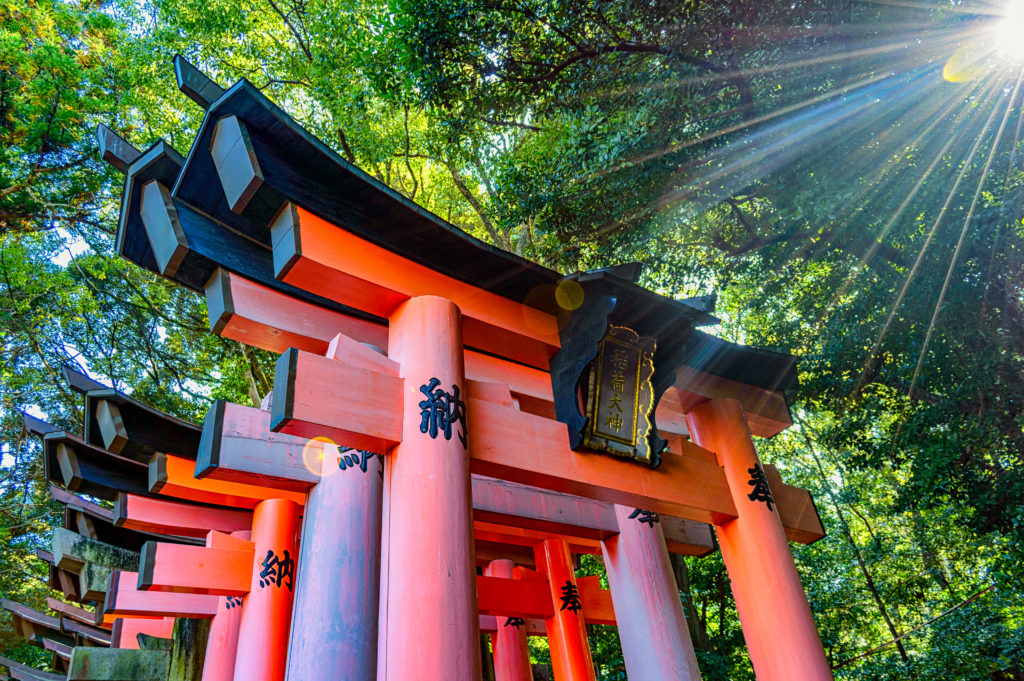 Torii gates, Mirko Kuzmanovic
Torii gates, Mirko Kuzmanovic
Some fast facts
Fushimi Inari Taisha Shrine is famous for its mystique torii gates laying in the forest area on the skirts of a mountain. The place enshrines the deity of Inari Okami which is the rice-harvest god or the god of success and fertility. There are about 4000 torii gates and around 30 sub-shrines, temples and rock altars open 24 hours a day. While it takes 2 hours to hike by taking the 4-km long path to the summit, most travelers only spend an hour by visiting the main shrine and the sen-bon torii gate tunnel that appeared in the movie “the Memoirs of Geisha” and won the prize of Japan’s top visited landmark on Tripadvisor 5 years in a row.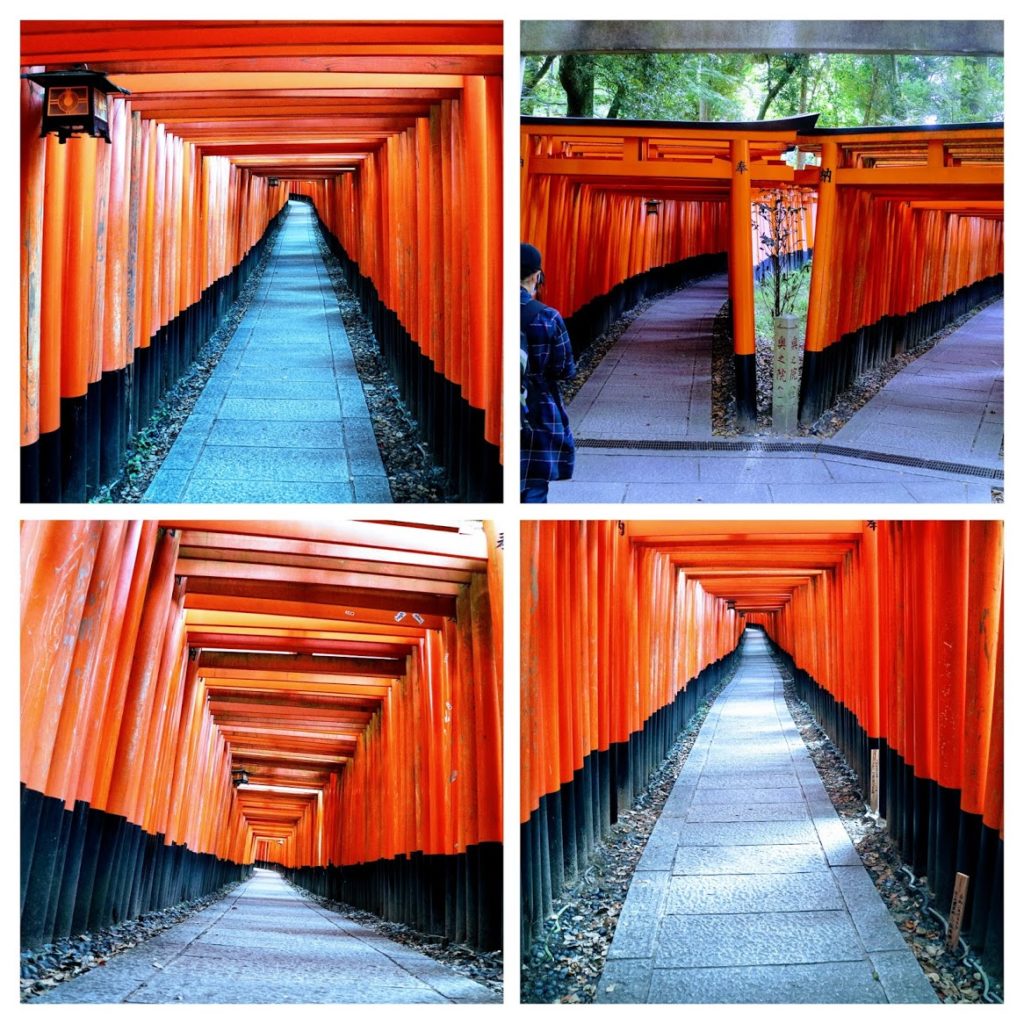 Fushimi Inari Taisha Shrine, The Sen Bon Torii Gate Area also known as the 1000 Gates Tunnel
Fushimi Inari Taisha Shrine, The Sen Bon Torii Gate Area also known as the 1000 Gates Tunnel
Historic Background
Fushimi Inari Shrine was built in 711 even before Kyoto was the capital. During the Heian Period it was already one of the most popular shrines in Japan, but got destroyed completely during the Onin Battle in the 1470’s. The main hall, honden, was constructed in 1499 and the huge Romon Gate was built in 1589. During the Meiji Period it was declared as one of the 3 main shrines throughout Japan, a kanpei taisha. Currently it is a precious cultural property and very popular among locals that is visited by almost half a million people on the new year’s day alone.
Fushimi Inari Walking Tour Map
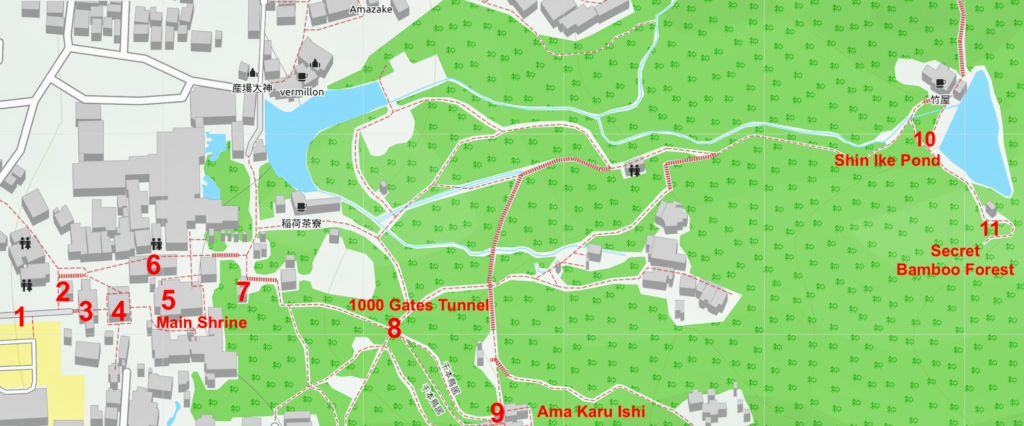 Fushimi Inari Tour Map #1 represents the Giant Torii gate and #11 represents the last pit stop before the climb. Explanation of each spot written below.
Fushimi Inari Tour Map #1 represents the Giant Torii gate and #11 represents the last pit stop before the climb. Explanation of each spot written below.
Things to do in Fushimi Inari
 Fushimi Inari Giant Torii Gate
Fushimi Inari Giant Torii Gate
1. The Giant Torii Gate
The T shaped vermillion colored gate that separates the sacred world and the material word. In Japanese these gates are called “torii” and symbolize the Shinto belief, so they are rarely found at Buddhist temples. These gates are usually made out of wood and colored in red as the red color is believed to keep evil spirits away and preserve the wood for a long time. Japanese people bow by entering the gate and do not walk in the middle as the middle path is reserved for deities.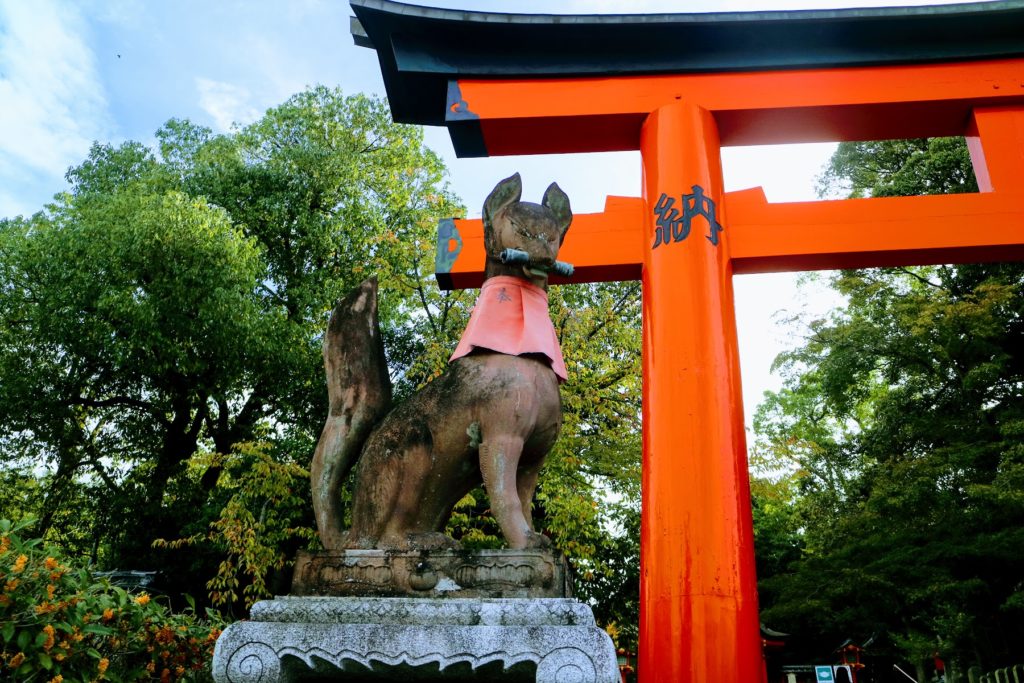 Fushimi Inari Fox holding Scroll
Fushimi Inari Fox holding Scroll
2. The Fox Statues
In front of the gate and many other places in the shrine you will notice fox statues. These foxes are messengers of the Inari Okami, the main deity of the shrine. The foxes usually have a ball (gem jewelry), scroll, key or rice straws in their mouth. The gem is the symbol of god and scroll is the message from god. Another explanation why foxes are sacred is that they eat rodents who damage rice crops. Some foxes hold a key in their mouth which represents the key to the rice storage houses. The red bib means the fox is protected from evil spirits who don't approach the red color. Fushimi Inari Romon Gate
Fushimi Inari Romon Gate
3. Main Gate (Romon Gate)
Before you enter the main gate you will pass the restrooms and the parking lot if you are coming from the JR station or swing by the restaurants and food stalls if you take the Keihan Line. First thing you’ll notice is the water basin where visitors symbolically purify themselves as a shinto ritual. Read this if you are wondering what is Shinto and how it is different from Buddhism. The main gate was built by the legendary warrior Toyotomi Hideyoshi in 1589 who pledged to build donate big sums of money if his mother recovered from her grave disease. His mother recovered and Toyotomi built this gate instead of donating the money. The warrior statues, zushin, on the right and left sides of the entrance are believed to protect the shrine from evil spirits. Fushimi Inari Gehaiden
Fushimi Inari Gehaiden
4. Gehaiden, the Worship Hall
After the Romon Gate, you will notice a stage with a roof which is the worship hall used for noh theater dance performances and public oratories. There are 12 iron lanterns hanging from the roof that represent the 12 zodiac signs. You will also notice rice straws, white zig-zag papers and rice strands decorating the building. Rice straws represent the clouds, the white zig zag papers are the flashes of the lightings and the strands symbolize the rain. Fushimi Inari Honden Main Shrine
Fushimi Inari Honden Main Shrine
5. Honden, the Main Shrine
The main shrine is where all the visitors head to in order to make a wish. This is a structure that is older than 500 years and a national treasure. Please get in the line as it may get busy and follow this procedure to make a wish: 1- throw a 5-yen into the wooden box 2- bow twice 3- clap twice and 4-make a wish. Please be respectful to other visitors and be quiet all the time. PS: Because of Covid 19, currently there are no ropes hung in front of the main hall.
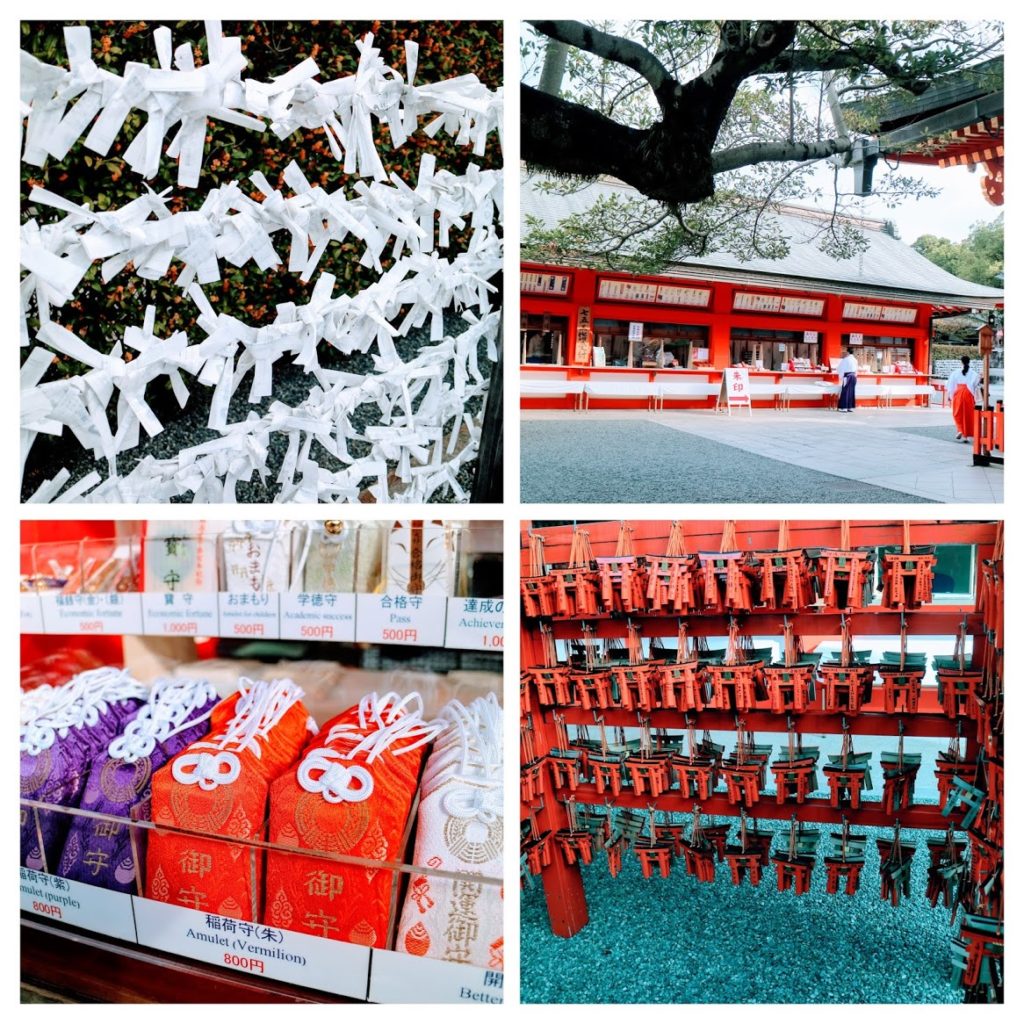 Fushimi Inari Omikuji Omamori Amulets Talismans
Fushimi Inari Omikuji Omamori Amulets Talismans
6. Talismans & Amulets at Ohuda
There is an office on the left side of the main shrine where you can purchase talismans and amulets. Most of the time a miko, shrine maiden who wears a white dress and an orange color skirt, will serve you. You can purchase little torii gates, amulets called omamori that can be carried as a protective guard, or fortune-telling paper strips called omikuji. The cost can be as low as 100 JPY to a few thousand yen as it usually depends on the size. If you buy an omikuji paper-strip, please make sure to keep it with you if it has good fortune but otherwise wrap it on the wires as shown in the picture above, so, the bad luck goes away. Fushimi Inari Horse Deity
Fushimi Inari Horse Deity
7. Shinmesha the Horse Deity
If you keep waking, you will see a small shrine with a gorgeous white horse statue that represents the horse that the god rides on. This little shrine was built in 1938. You will notice many cards and pieces of paper thrown thru the little hole on the glass window as the locals believe leaving a business card inside the shrine is a good fortune for the business.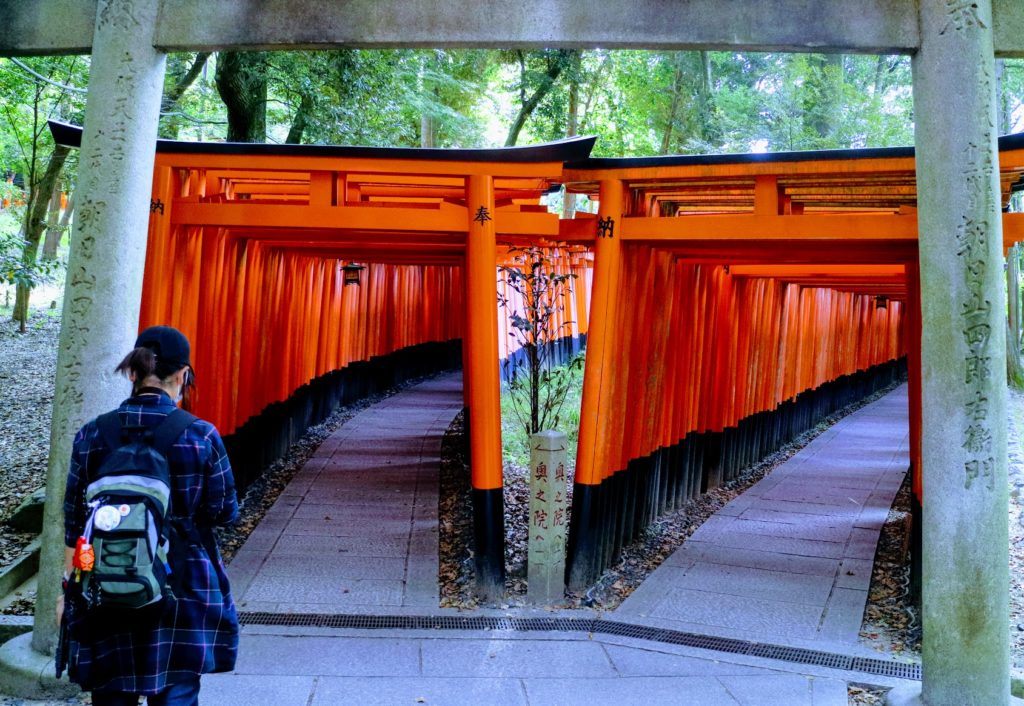 Fushimi Inari 1000 Gates
Fushimi Inari 1000 Gates
8. Senbon no Torii Tunnel, 1000 Gates
The entrance of the Senbon no Torii Gate tunnels is the most picturesque spot of Fushimi Inari, if not the whole of Japan. It is only about a 2-minute walk behind the main shrine where the gates appear like a tunnel made out of a red wall. Please take the right tunnel and keep walking. Sen-bon no torii means 1000 torii gates since there are so many of them in a small area. As it gets crowded, there are only two ways to take a picture without a stranger in your photo a) visiting before 9 am or 5 pm or b) hiking up the hill where there are many similar spots but very few people.
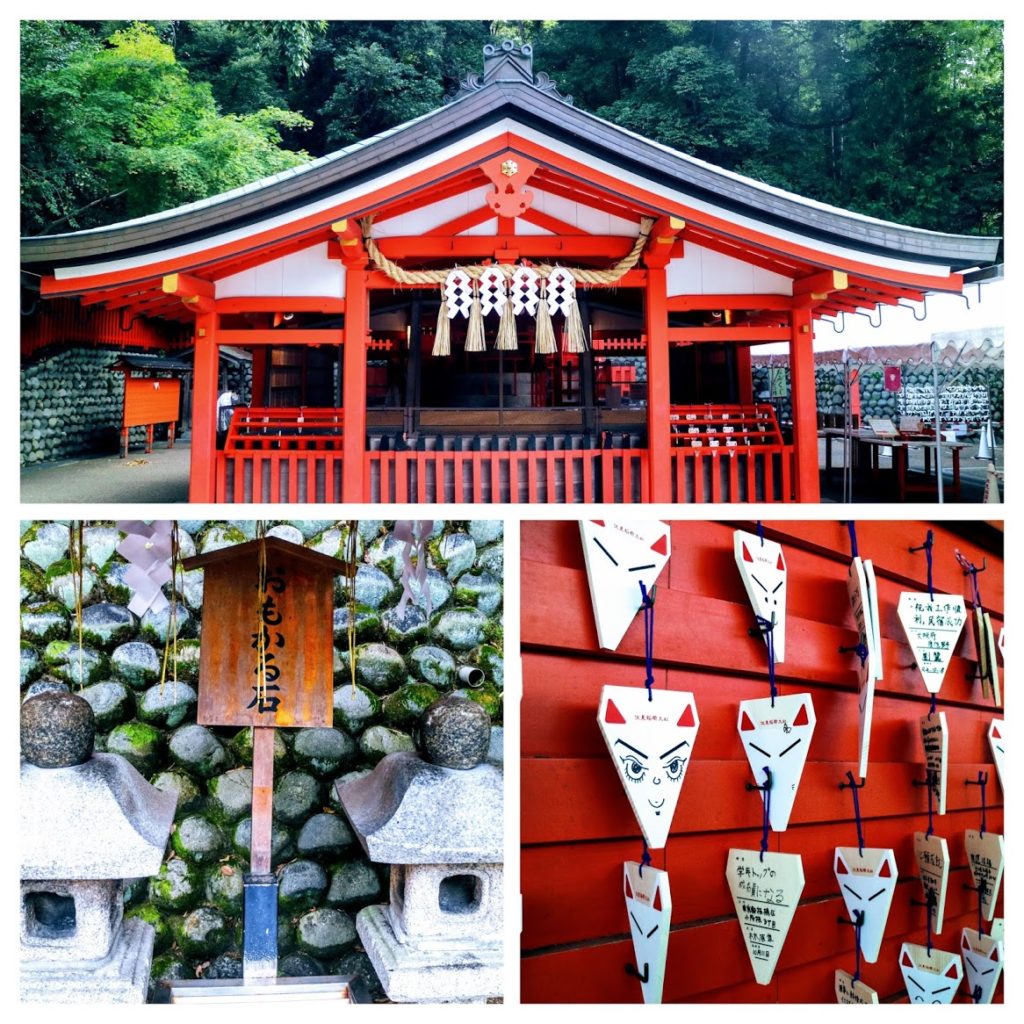 Fushimi Inari Omo Karu Ishi and the Okusha Shrine
Fushimi Inari Omo Karu Ishi and the Okusha Shrine
9. Omokaru Ishi & Okusha Shrine
At the end of the Senbon Torii gateway, you will reach the Okusha shrine where you will find more amulet stands and hundreds of wooden tablets shaped like a fox head hung on the walls. The Okusha Shrine was originally built in 1499 but destroyed in the 1700s before the final construction in 1975. On the right side you will see omokaru ishi which means heavy and light stones. The omo karu ishi are 2 lanterns with 2 sizable rocks on each that can predict whether your wish will come true or not. Just make a wish in your mind and then lift one of the stones. If the stone is heavier than what you thought the weight would be, your wish will come true, otherwise it won’t.
 Fushimi Inari Shin Ike Pond
Fushimi Inari Shin Ike Pond
10. Shin Ike Pond
About half the visitors end their trip at the Okusha Shrine by returning on the same gateway. If you, however, walk under the tori gates that are on the left side of the Okusha Shrine, you will reach the beautiful Shin Ike pond in about 5 minutes. This place is also called Kumatakasha known as the first pit stop on the way to the summit. The pond is surrounded by so many rock altars and small shrines erected in honor of various deities creating an atmosphere like a scene from an old samurai movie. You can purchase a candle or incense from the kiosk, light it and place it on the rack to wish for something until it burns down.
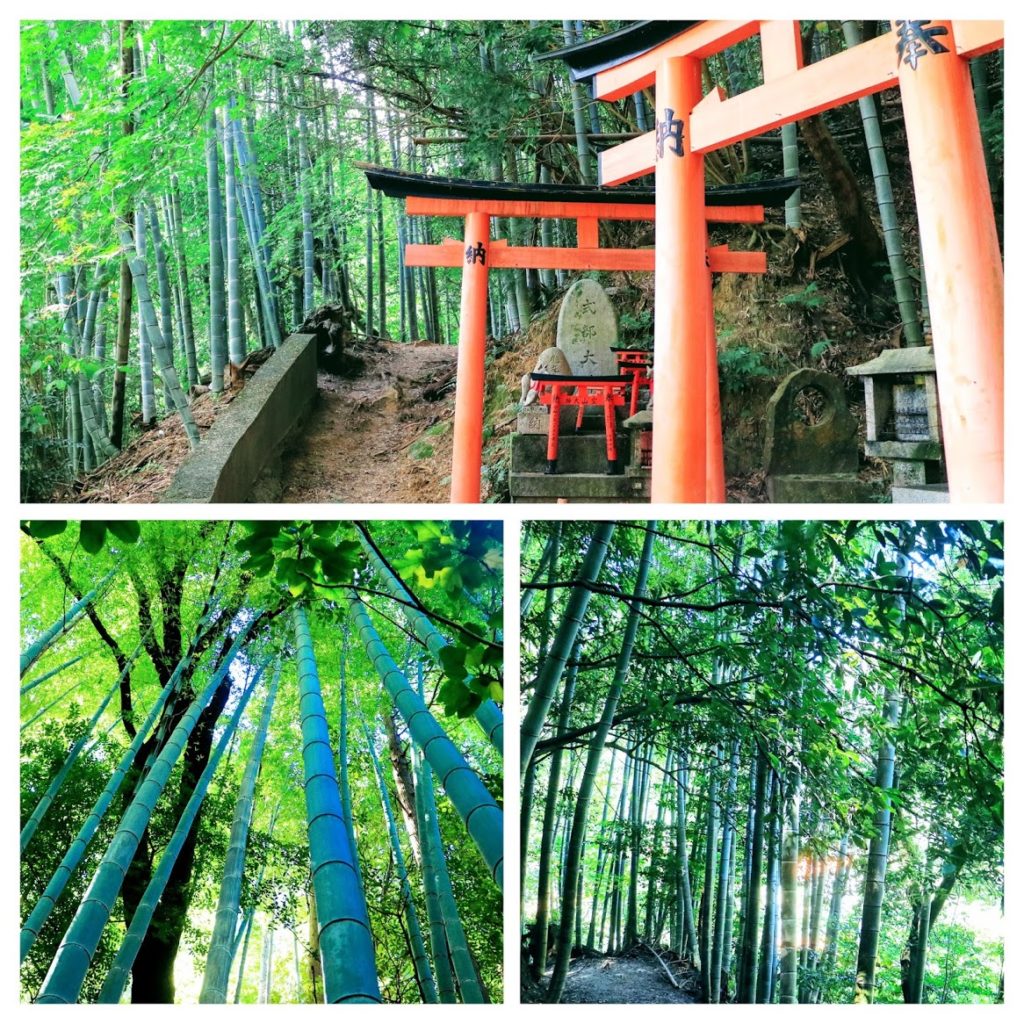 Fushimi Inari Bamboo Forest
Fushimi Inari Bamboo Forest
11. The secret Bamboo Forest in Fushimi Inari
If you walk all the way to your right after you see the Shin Ike Pond, and then, make a left, you will discover this lovely bamboo forest pictured in the photos above. The bamboo is the fastest growing plant in the world and there are actually multiple spots in Fushimi Inari where you can enjoy walking under the serene bamboo branches. All you need to do is walk near the gates, not under, after passing the Sen Bon Tori area. Here is another bamboo spot on Google Maps just in case you cannot locate the first one. Nishimura Tei Cafe in Fushimi Inari
Nishimura Tei Cafe in Fushimi Inari
Nishimura Tei Cafe
It would take you roughly another 15 minutes to reach the first major pit stop, the Yotsutsuji Station with a decent view of the city, a bunch of benches to sit on and the Nishimura Tei Cafe. Nishimura Tei is a relaxing rest area where you can order noodles, ice cream, Japanese local delicacies and various kinds of drinks. The cafe also has a wonderful view from the inside and a nice cooling system that comes handy on a hot day. Their signature dish is the matcha warabi sweets you can see in the picture. An additional 25 minute hike would take you to the summit from there but most travelers end their hike and return back.
Recommended Restaurants & Cafes by the Entrance
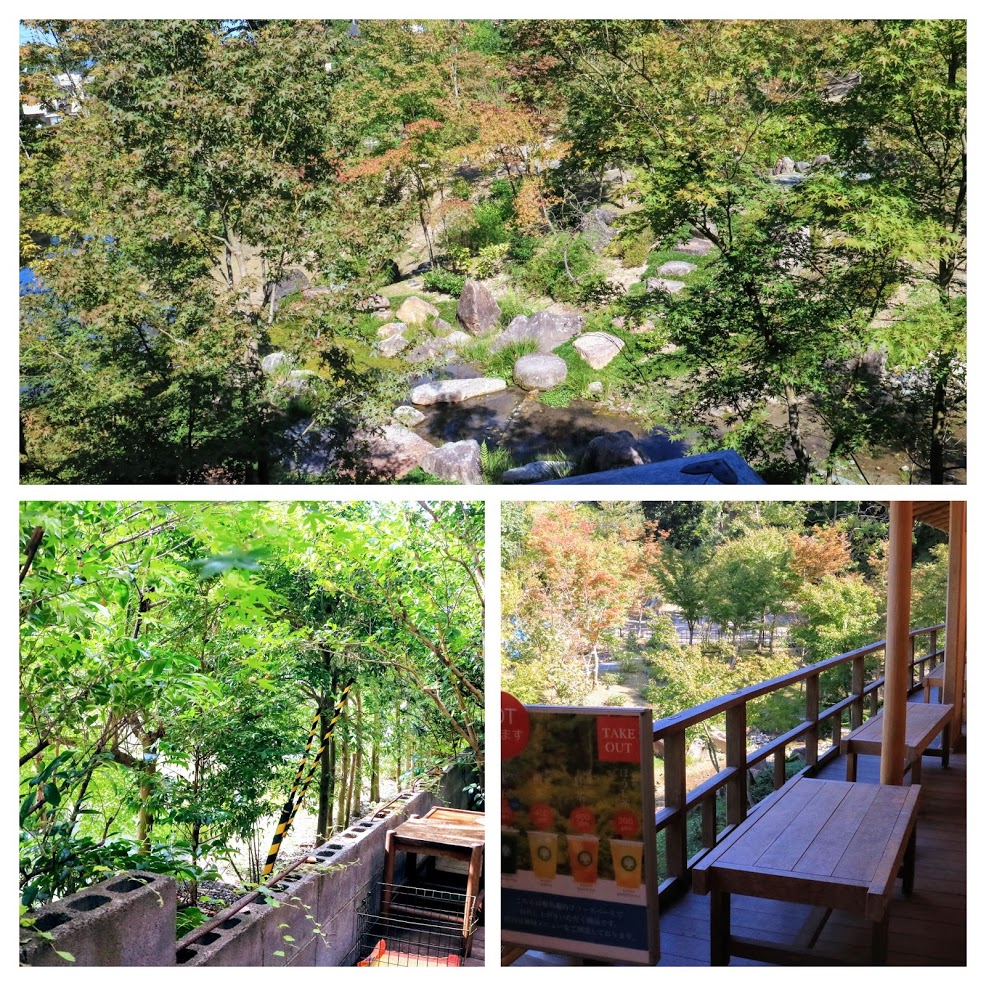 Recommended Cafe near Fushimi Inari (Bottom Left:Vermillion Cafe, Bottom Right: Inari Saryo Cafe)
Recommended Cafe near Fushimi Inari (Bottom Left:Vermillion Cafe, Bottom Right: Inari Saryo Cafe)
There are many food stalls, cafes and restaurants right outside of the Fushimi Inari Shrine. The food stalls usually sell the beef skewers, fried chicken and fried noodles. If you are a foodie, you should try the fried noodles but for people like myself it may not be fun to stand and eat. I usually grab a matcha ice cream at the Vermillion Cafe where I can enjoy the view of the pond and choose from various options including freshly brewed coffee, sandwiches and veggie options. If I am not hungry I just grab a matcha ice cream at the Inari Saryo Cafe which also has a view of a Japanese garden.
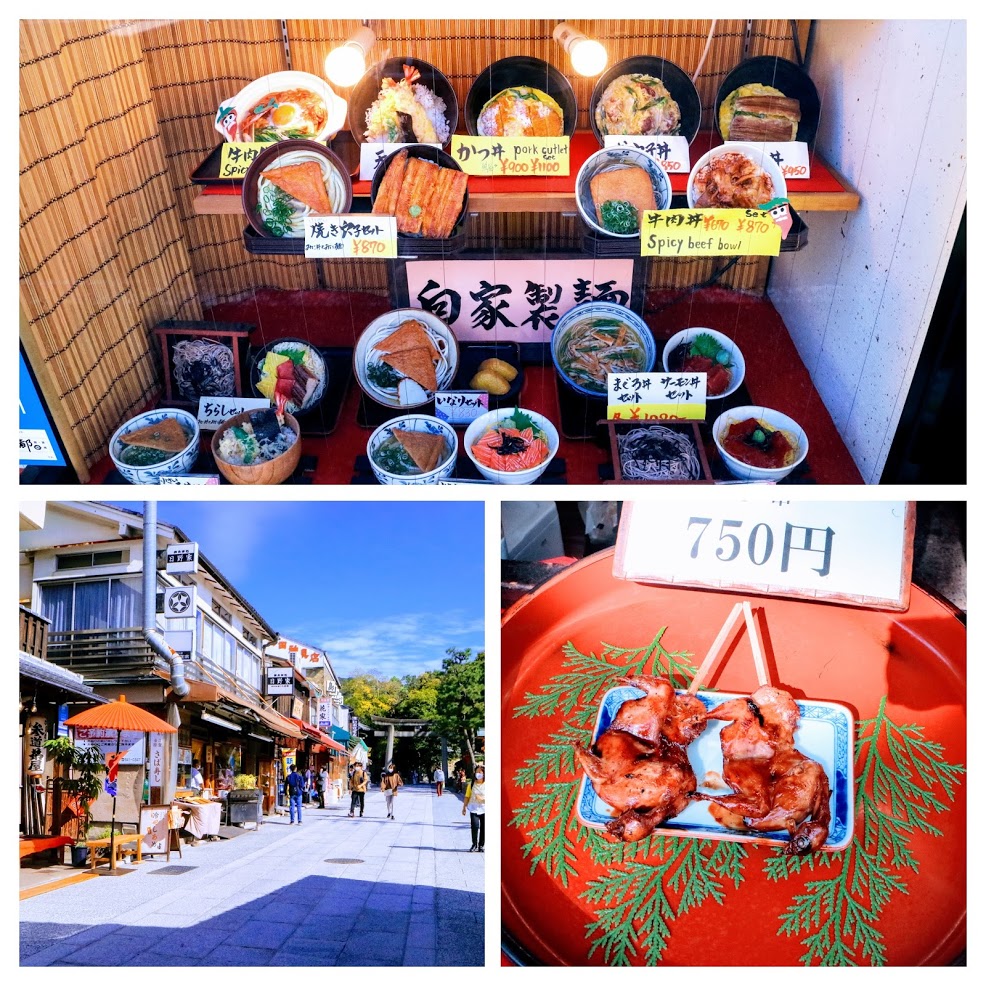 Eating Options near Fushimi Inari (Bottom Right: Fried Quails at Inafuku)
Eating Options near Fushimi Inari (Bottom Right: Fried Quails at Inafuku)
Many travelers want to try the grilled quail at Inafuku where you can also eat udon noodles, chicken skewers, omelette, and deep fried vegetables. Please remember that almost all the shops in Fushimi Inari have tiny spaces and small seats where a dish in avg. costs around 8 USD. Inari Dohachi, tucked away from the main street, has a bit more authentic atmosphere and delicious ramen and udon noodles for a reasonable price.
Things to do Nearby: Tofukuji Temple and Sake Breweries
Seasoned travelers know that the real gem, especially during the autumn season, is the Tofukuji Temple, only a stop away from Fushimi Inari. Tofukuji is one of the oldest zen temples in Japan with calming zen gardens. It is perhaps the most visited scenic fall-leaves viewing spot by locals. Fushimi is also famous for its sake breweries; you can swing by various sake shops or try sake at the Gekkeikan Okura Sake Museum.
How to get back
 Fushimi Inari Keihan Transportation Map © KEIHAN
Fushimi Inari Keihan Transportation Map © KEIHAN
Most travelers jump on the Keihan Line and head to the Kiyomizu Temple area by getting off at the Kiyomizu Gojo Station. If you want to go to Nishiki Market, Pontocho, the Gion Geisha District then please get off at the Gion Shijo Station. You can also go the Imperial Palace by getting off at the Jingu Marutamachi Station. It only takes about 10 minutes from Fushimi Inari to the downtown area.
Frequently asked Questions
How long should I spend at Fushimi Inari
Most people spend between 1 and 2 hours at Fushimi Inari Shrine. Fushimi Inari is not a single landmark; it is a mountainous area housing more than 30 shrines spread over a 4-km long hiking path. Most people do not go to the top and return after visiting the Sen Bon no Torii spot. If you chose to hike to the summit then you would spend roughly 3 hours.Should I hike all the way to the summit?
If you like hiking and if you have enough time in Kyoto, then seeing the shrine at the summit would be rewarding. However, I personally am not impressed with the view because it is all buildings and what you see is not the historic area of Kyoto.
How much is the entrance fee?
It is free, there is no entrance fee.
What are Fushimi Inari Taisha's Visiting Hours?
It is open 24 hours a day. The lights are on and there is a security camera system, so, many travelers and photographers visit the place at night.
How many Torii Gates are there?
The exact number is not known but it is reported to be between 4000 and 10,000. Difficult to know the exact number because of the size of the torii gates. Even visitors can purchase a small torii and put it there, thus increasing the number. The cost of the torii gate depends on the size and location, however, the big ones usually cost around 10,000 USD. You can see the name of the donator on the one side and the date it was donated on the other side.As a matter of fact just until 200 years ago, there were not many gates. These gates were donated to the shrine in the recent past. The trends reportedly was started by the Mitsukoshi Department Store's owner, the oldest department store in the world. After he donated a torii gate to the shrine, the business boomed and then many business owners followed suit. Small gates, small donation, big gates big donation.
Do people still donate torii gates?
Yes the number of torii gates is going up and you can still donate a torii gate. This is actually one of the ways the shrine can survive the economic difficulties. However, the gates are made out of wood and there are many big gates that are damaged.
Fushimi Inari Reviews
Sources:
Inari Pilgrimage by Karen A. Smyers
Shinto: A History by Helen Hardacre
Kyoto and Nara Tuttle Travel Pack by Rob Goss
Image Credits: All the images of Fushimi Inari and the neighboring areas belong to Kimono Tea Ceremony Kyoto Maikoya. Copyright © Kimono Tea Ceremony Kyoto Maikoya. Fushimi Inari Tour Map is owned by OpenStreetMap.










